|
Our
curricula offerings in Mathematics has a new member in
the Foundations of Mathematics Activity Book.
While the content focus is the same as Foundations of
Mathematics, the activities themselves are, first
and foremost,
interactive. We have taken all of
our expertise in how students learn best and most
effectively — through engaged discovery and active
problem-solving
— and used that as the basis for this
book. This is not a textbook; there are no long
discursive passages about place values or the various
properties of addition. There are a thousand textbooks
that offer that kind of informational content. What we
offer is a kind of practical math laboratory where
students take the information their textbook imparts and
work with it, play with it, and explore it. It is precisely through this kind of active and
interactive exploration that students begin to take
ownership of their learning. |
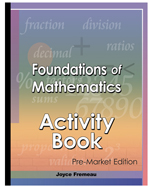 |
|
But because a picture is worth a thousand
words (and as surprising as it may be, we are aware of our tendency toward
verbosity on topics that excite us), we'd like to share
a few samples of the exciting and powerful features of these
activities, as well as some of the thinking behind those
features. |
 |
Each activity begins
with a real-world math problem. Students should be
able to solve this problem, if they have both
knowledge and comprehension of the applicable
information available in their math textbook. This
is an instance of application, the third level of
Bloom's Taxonomy. |
|
|
|
|
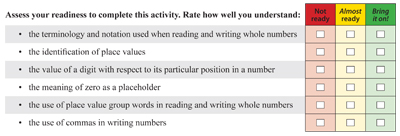 |
Once students have
completed the contextualized math problem, they are
given the opportunity to self-assess their readiness
to do more. The dimensions of this assessment are
taken from the core learning objectives for the math
content (i.e., what students should
understand, if they have truly learned).
|
|
|
|
|
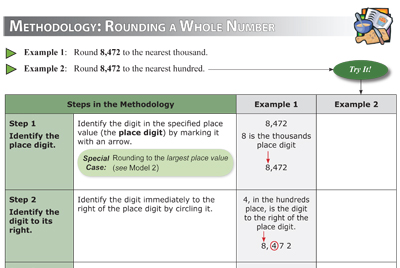 |
In learning processes, students
often resort to memorizing what an
instructor models. Since
the steps are not generalized, students see each context as
new knowledge to memorize and find it
impossible to generalize from a set of
examples and practice problems. By
providing a concrete model of the process,
learners can analyze how each step
supports the process, helping them
quickly and effectively arrive at a
verifiable solution. The most important Innovation is
Example 2, an opportunity for students to complete a "Try It!"
problem, side-by-side with the given example. The goal
of this is to help students immediately generalize
their understanding beyond a single example. Students
must begin to see that even if the specifics
of the information changes, the rules, steps, and
processes remain the same.
|
|
|
|
 |
Models are
contextually worked-out examples that
demonstrate the steps of the methodology
in solving
given problems.
An activity
always uses multiple models that
illustrate new contexts even as they advance in
difficulty so learners can compare and
contrast the models to further generalize
the methodology. Complete modeling is
presented, including validation.
Models are a critical step in the Learning
Process Methodology, and are one of the
most time-tested pedagogical techniques
because the illustration of the expert
makes the context comes alive in meaning
and understanding for the novice.
|
|
While we use models in all of our math curricula,
the real innovation here is the "Make Your Own
Model" component. Students are instructed to create a
model demonstrating how to solve the most
difficult problem they can think of.
Because students determine the problem, it is kept
at a level of complexity they can handle (they are
not likely to know enough yet to create a problem
that the methodology does not address), while
simultaneously maximizing their learning development
through increased challenge. Students enjoy
challenging an instructor; they like to ask the
"Yeah, but what about..." questions. This section
harnesses that impulse and allows students to take
increased ownership of their learning.
|
|
|
|
|
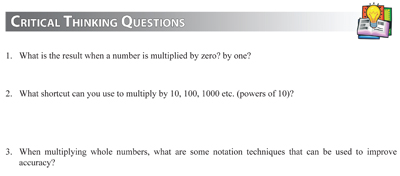 |
The Critical Thinking
Questions are designed to maximize
comprehension, meaning, and understanding. The range of learning issues associated
with activity content is addressed with
the complete set of questions. This component
of the activity prepares the learner
to be able to quickly transfer the
knowledge to new context and after a few
diverse exercises, allow the learner to
generalize this knowledge to
transfer across any appropriate context. |
|
|
|
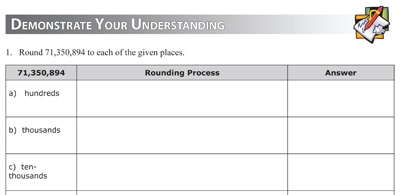 |
This section continues to work on Level-3 knowledge
(application). The problems provide students with a
minimal set of challenging exercises to
practice transferring and generalizing
their knowledge so they can meet the
performance criteria for the learning
activity. The set of exercises
provides a graduated level of difficulty to
verify to the learner that they can
address the various aspects of the use of
the knowledge.
|
|
|
|
|
 |
Students are now given the opportunity to
demonstrate their mastery of content by identifying
and correcting errors made by others. Instructors
understand how powerful this process is and how well
it serves to increase understanding of the thinking
and processes used in solving math problems.
When an answer does not validate, many students'
first instinct is to erase the entire problem and
begin again. This does not strengthen students'
skills; in fact it is a behavior that has much in
common with evaluation rather than assessment, as a
judgment has been made (the answer is wrong) with no
further analysis of where things went wrong. If
students are led to discover the nature of the
error, and then to demonstrate the correct process,
assessment behavior is enforced, helping students to
become stronger self-assessors, and more able to
strengthen their own performance. |
Foundations of Mathematics
Activity Book
is available
for adoption for
Fall 2009.
To learn more, please
contact us!
|

